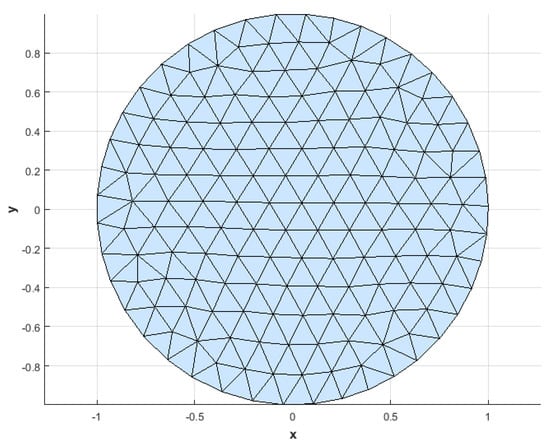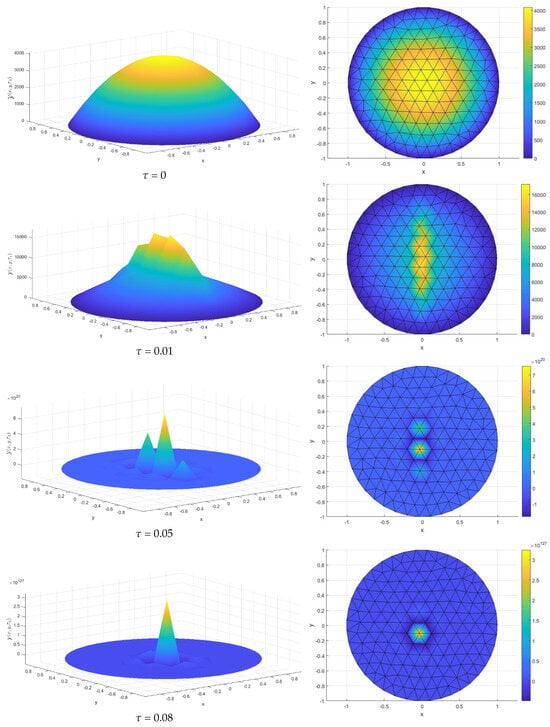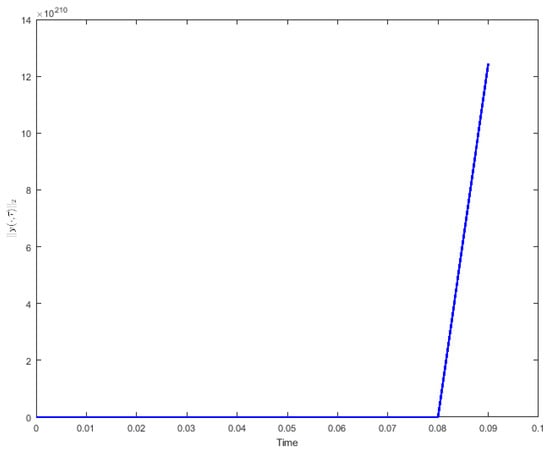Abstract
The subject of this study is a nonlinear viscoelastic plate equation with variable exponents and a general source term. Through the application of the Faedo–Galerkin approximation method and a fixed point theorem under appropriate assumptions, we proved the existence of weak solutions.
Keywords:
partial differential equations; boundary value problems; existence; viscoelastic; variable exponents; nonlinear equations MSC:
35L35; 35L20; 93D20
1. Introduction
In this study, we consider the following nonlinear viscoelastic plate problem
where is a bounded domain in with , and is a smooth boundary.
is small enough and will be determined later.
Firstly, we make some assumptions about the functions and p:
and
Also, we insert the Log-Hölder continuity condition
for all , where and with
Variable exponent PDEs are present in different fields of science such as elasticity theory, nonlinear electrorheological fluids, image processing, and filtration processes in porous media [,,,,,,].
Hamadouche [] studied the local existence and blow-up of solutions to the Petrovsky problem
with no viscoelastic term, i.e., ().
A variable exponent nonlinear viscoelastic problem was invesitigated by Al-Mahdi et al. In []
they also provided some stability results.
Park and Kang in [] and Piskin in [] considered a similar problem involving a variable exponent in the second term, using the following equation
and proved results on the existence and blow up of solutions.
The aim of this paper is to prove the local existence of weak solutions for problem (1), which can be seen as a generalization of many previously cited nonlinear viscoelastic problems. To achieve this, we used the Faedo–Galerkin approximation method and a fixed point theorem.
Before stating our main result, let us recall some necessary preliminaries.
2. Preliminaries
In this section, we present fundamental concepts related to variable exponent Lebesgue and Sobolev spaces ([,,,]). Moreover, we will provide crucial assumptions and lemmas.
Let be a domain in , let and be a measurable function. The variable exponent Lebesgue space is defined by
where
This is a Banach space equipped with the Luxembourg-type norm
We also consider the following variable exponent Sobolev space
In the following lemmas, we assume that p is a measurable function on satisfying (3).
Lemma 1
([]). A positive constant B exists, veifying
i.e., the embedding is compact and continuous.
In paticular, the embedding is also compact and continuous.
Lemma 2
([]). For almost every , we have
for all
Now, we suggest these assumptions about k:
- (H1)
- is a non-increasing function of class satisfying
- (H2)
Some calculations lead to
where
Lemma 3
([]). Assuming that with
and
Then,
where
Furthermore, satisfies
3. Existence of Local Solution
In this section, we examine the local existence result for problem (1), which can be acquired throught the Faedo–Galerkin approximation technique. Presently, we investigate the fourth-order initial-boundary value problem as follows:
Theorem 1.
Proof.
Existence: We begin this proof by introducing the finite-dimensional subspace , where is an orthonormal basis of , i.e.,
Through normalization, we obtain and for any given integer we investigate the approximate problem
where and are both sequences in and respectively,
As we obtained a system of ordinary differential equations, we can justify the local existence of solutions to the problem (9) uisnfg the Picard–Lindelof theorem. This solution exists localy in interval with for all . Then, we show that it can be extended to for any given .
Multiplying (9) by and sum over i, we obtain
an integration over leads to
So, we obtain
Therefore, the solution can be extended to , indeed
So, we can extract from such that
As stated by Lions lemma (see []), we obtain that ; . As is bounded in , then
Then, just like in Messaoudi et al. [], we conclude
Hence,
which provides
Uniqueness: Suppose that (8) admits two solutions and Then, satisfies
After multiplication by and integration over we obtain
Then, from inequality
∀ and almost every x , we get
Therefore , since on □
Theorem 2.
Proof.
Using Theorem 5, for evey , there exists a unique
that veifies
Let us define the following map by where
we associate to this space the following norm
a multiplication by in (12), then, an integration over the domain leads to
From the Sobolev embedding and a Young’s inequality, we obtain
where is the embedding constant. From (5), we obtain
Taking , such that , we obtain
where We assume that for and By ensuring T is large enough to verify
and S is small enough so that
we have
Now, consider , where .
Let us prove that it is a contraction.
4. Numerical Study
Here, we present a numerical exemple by providing initial data and numerically illustrating the behavior of the solution for problem (1). For this, we utilize a numerical scheme relying on the finite element method for dimension .
For the sake of simplicity, let and .
Multiplying the equation in problem (1) by , integrating it over and using the Green formula, we obtain
with and .
To approximate the solution, we utilize a Galerkin finite element method for discretization. Let
Each is a component of the triangulation, where E is the reference simplex and is an invertible affine transformation.
We introduce the related finite element space by
represents the set of polynomials with a maximum degree of one on E.
Substituting with the finite-dimensional subspace , we obtain the subsequent semi-discrete form of (20),
with and , where is the projection from onto .
Now, consider the nodal basis of denoted by , then we can provide the approximate solution by
with being coefficients that vary over time.
For , which is a patition of , where , and . Using (24) and taking , in , we realize that the approximate solution
veifies the following matricial problem
here, M and R represent the mass and stiffness matrices, respectively, associated with the shape operators.
Now, we employ a Newmark method to solve the problem (26). So, in this two-dimensional scenario (), we consider the following choices:
and initial conditions:
There are 281 triangles in the triangulation . Using MATLAB, we created a mech geneator, as shown in Figure 1. The time step is small enough .

Figure 1.
Uniform mesh grid of .
Depending on various time iterations (), (), (), and (), we provide the aproximate solutions In Figure 2. The solutions are displayed in 3D and their 2D projections are shown in the right column for better visualization. Notice that the colors indicate the values.

Figure 2.
Numerical values of at different times.
Also, the numerical values of are displayed over time in Figure 3, indicating an interesting blow-up for this solution at , which has been observed for many other numerical examples tested using these problems. A theoretical study of blow-up in time for the solutions to our problem is needed to confirm these obsevations.

Figure 3.
.
5. Conclusions
In this work, the existence of a weak solution to problem (1) has been obtained via the Faedo–Galerkin approximation method and a fixed point theorem. The result can be seen as a generalization of many similar existence results in the literature, with only a few conditions on the general source term . Regarding future research, using energy methods, it may be possible to apply Lemma 3 and impose additional conditions on the second term to study the asymptotic behavior of these solutions.
Author Contributions
Y.B.: writing—original draft, methodology, resources, methodology, formal analysis, conceptualization; S.B. and A.A.: conceptualized, investigation, analyzed and validated the research; S.B. and A.A.: formulated, investigated, reviewed, and supervised; S.B.: corresponding author, supervision. All authors have read and agreed to the published version of the manuscript.
Funding
The researchers would like to thank the Deanship of Graduate Studies and Scientific Research at Qassim University for financial support (QU-APC-2024-9/1).
Institutional Review Board Statement
There is no ethical issue in this work. All of the the authors actively participated in this research and approved it for publication.
Data Availability Statement
There are no data associated with the current study.
Acknowledgments
The Researchers would like to thank the Deanship of Graduate Studies and Scientific Research at Qassim University for financial support (QU-APC-2024-9/1).
Conflicts of Interest
There are no competing interests regarding this research work.
References
- Aberqi, A.; Bennouna, J.; Benslimane, O.; Ragusa, M.A. Existence Results for Double Phase Problem in Sobolev. Orlicz Spaces with Variable Exponents in Complete Manifold. Mediterr. J. Math. 2022, 19, 158. [Google Scholar] [CrossRef]
- Bakery, A.A.; Mohamed, E.A.A. Fixed point property of variable exponent Cesaro complex function space of formal power series under premodular. J. Funct. 2022, 2022, 3811326. [Google Scholar] [CrossRef]
- Chen, W.; Zhou, Y. Global nonexistence for a semilinear Petrovsky equation. Nonlinear Anal. 2009, 70, 3203–3208. [Google Scholar] [CrossRef]
- Choucha, A.; Boulaaras, S.; Jan, R.; Alharbi, R. Blow-up and decay of solutions for a viscoelastic Kirchhoff-type equation with distributed delay and variable exponents. Math. Meth. Appl. Sci. 2024, 47, 6928–6945. [Google Scholar] [CrossRef]
- Diening, L.; Hasto, P.; Harjulehto, P.; Ruzicka, M.M. Lebesgue and Sobolev Spaces with Variable Exponents; Lecture Notes in Mathematics; Springer: Berlin/Heidelberg, Germany, 2017. [Google Scholar]
- Ruzicka, M. Electrorheological Fluids: Modeling and Mathematical Theory; Lecture Notes in Mathematics; Springer: New York, NY, USA, 2000. [Google Scholar]
- Yilmaz, N.; Piskin, E.; Boulaaras, S. Viscoelastic plate equation with variable exponents: Existence and blow-up. J. Anal. 2024, 1–26. [Google Scholar] [CrossRef]
- Hamadouche, T. Existence and blow up of solutions for a Petrovsky equation with variable-exponents. SeMA J. 2022, 80, 393–413. [Google Scholar] [CrossRef]
- Al-Mahdi, A.M.; Al-Gharabli, M.M.; Noor, M.; Audu, J.D. Stability Results for a Weakly Dissipative Viscoelastic Equation with Variable-Exponent Nonlinearity: Theory and Numerics. Math. Comput. Appl. 2023, 28, 5. [Google Scholar] [CrossRef]
- Park, S.H.; Kang, J.R. Blow-up of solutions for a viscoelastic wave equation with variable exponents. Math. Meth. Appl. Sci. 2019, 42, 2083–2097. [Google Scholar] [CrossRef]
- Pişkin, E. Blow up of solutions for a nonlinear viscoelastic wave equations with variable exponents. Middle East J. Sci. 2019, 5, 134–145. [Google Scholar] [CrossRef]
- Fan, X.; Zhao, D. On the spaces Lp(x)(w) and Wm,p(x)(w). J. Math. Anal. Appl. 2001, 263, 424–446. [Google Scholar] [CrossRef]
- Ouchenane, D.; Boulaaras, S.; Choucha, A.; Alngga, M. Blow-up and general decay of solutions for a Kirchhoff-type equation with distributed delay and variable-exponents. Quaest. Math. 2023, 47, 43–60. [Google Scholar] [CrossRef]
- Pişkin, E.; Okutmuxsxtur, B. An Introduction to Sobolev Spaces; Bentham Science: Oak Park, IL, USA, 2021. [Google Scholar]
- Korpusov, M.O. Non-existence of global solutions to generalized dissipative Klein–Gordon equations with positive energy. Electron. J. Differ. Equ. 2012, 2012, 1–10. [Google Scholar]
- Lions, J.L. Quelques Methodes de Resolution des Problems aux Limites Non Lineaires; Dunod: Paris, France, 1969. [Google Scholar]
- Messaoudi, S.A.; Talahmeh, A.A.; Al-Smail, J.H. Nonlinear damped wave equation: Existence and blow-up. Comput. Math. Appl. 2017, 74, 3024–3041. [Google Scholar] [CrossRef]
Disclaimer/Publisher’s Note: The statements, opinions and data contained in all publications are solely those of the individual author(s) and contributor(s) and not of MDPI and/or the editor(s). MDPI and/or the editor(s) disclaim responsibility for any injury to people or property resulting from any ideas, methods, instructions or products referred to in the content. |
© 2024 by the authors. Licensee MDPI, Basel, Switzerland. This article is an open access article distributed under the terms and conditions of the Creative Commons Attribution (CC BY) license (https://creativecommons.org/licenses/by/4.0/).